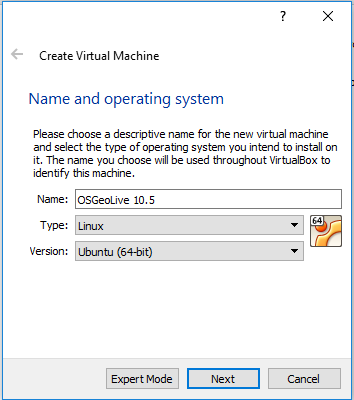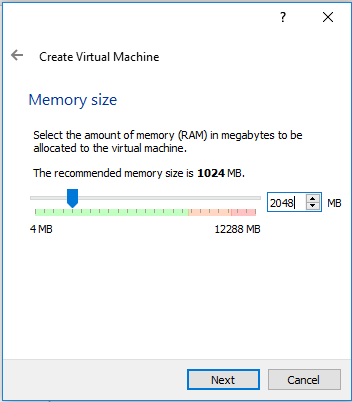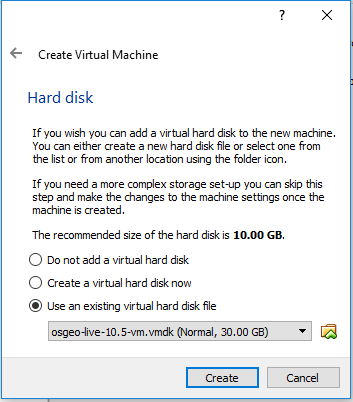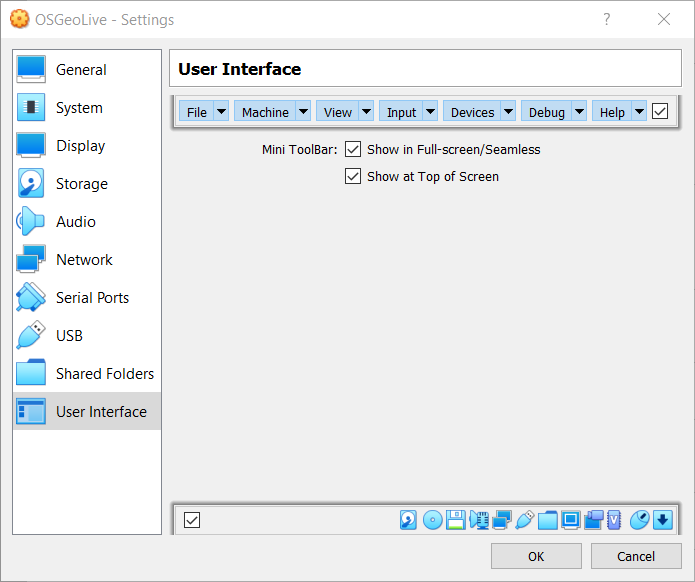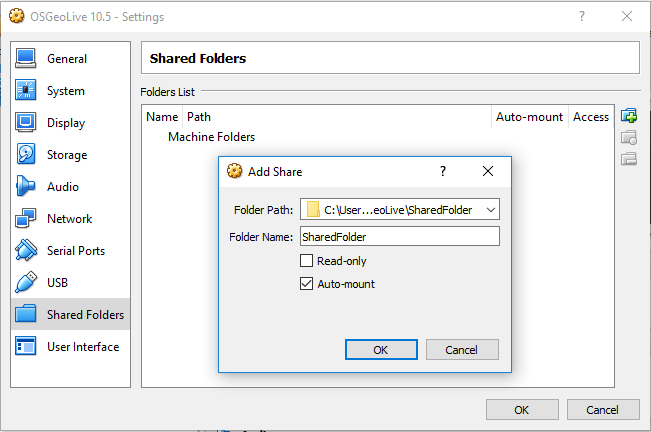Ausführen einer virtuellen Maschine¶
Übersicht¶
This Quick Start describes one way to run OSGeoLive within a VirtualBox virtual machine (VM). For other methods, follow links from the „See Also“ section below.
Bemerkung
To learn more about the benefits of virtualization, see Virtualization in Wiki
Voraussetzungen¶
Software
Download Virtual Box for your platform, and install the software. On Windows run the installer, or on Ubuntu-like Linux systems run the following:
apt-get install virtualbox-oseDownload the OSGeo Virtual disk file (vmdk) from live.osgeo.org.
Under osgeolive-vm, download the 7-zip file. Then unzip the downloaded file (using 7zip ).
Hardware
RAM: Minimum 2 GB. The Lubuntu system runs well with 1 GB of RAM, and you’ll need to keep at least the same amount of memory for some of your applications (such as GeoServer). So a total of 2 GB is recommended for a smooth operation.
Spare: Minimum 20 GB Hard Disk Space. The virtual disk file (vmdk) from live.osgeo.org unzips to almost 10 GB. You’ll also want more space to allow some room to work on the virtual machine. So a total of 20 GB is a good recommendation.
CPU: Any CPU will do, but a processor which supports „Virtualization Technology“ will be faster. Check if your computer supports Virtualization Technology
Bemerkung
Most machines produced after 2010 will meet these requirements.
Step 1 : Create a Virtual Machine¶
Start the VirtualBox application and click New. Create Virtual Machine pop up is displayed.
Enter a name such as OSGeoLive, and select Linux as the „Operating system“, and Ubuntu as the „Version“, and then click Next.
In the next screen set the memory to at least 1024 MB (or more if your host computer has more than 4GB, like in the screenshot below).
Continue to the next screen and select Use an existing virtual hard disk file. Click the folder icon to browse to where you saved the OSGeoLive vmdk-file. Select the file, click Next and Create.
Step 2: Configure VM¶
VM Settings
Once the VM is created, click the Settings button. In the User Interface section, click to select Show at top of screen for the Mini toolbar.
Go to the Display section and increase video memory to 32 or 64 MB. In some host operating systems, it may be required to „Enable 3D Acceleration“ for display to work properly.
Add shared folders to access files from host
Go to the Shared Folders section, and click the Add folder (green + icon on the right) to find a directory on your host computer that you wish to share inside the VM.
Dabei können gemeinsame Ordner wahlweise nur lesend und automatisch verbunden werden. Klicken Sie ok, sobald der „Ordnerpfad“ und „Ordnername“ definiert wurde und nochmals OK, um die Einstellungen zu speichern und das Fenster zu schließen.
Step 3 : Running the Virtual Machine¶
Now bootup the VM by clicking the Start (green arrow) button.
The OSGeo-Live virtual display (i.e., the window size) may be very small, and will not be able to increase until you install Guest Additions. You should install the virtualbox guest additions, this will allow you to use full-screen mode.
sudo apt-get install --yes virtualbox-guest-utils virtualbox-guest-x11
(Alternative) If the above command does not work, use the following alternative:
From the VirtualBox Devices menu, select Insert Guest Additions CD Image
Click OK when prompted to open the removable media in File Manager.
In File Manager, select Tools → Open Current Folder in terminal.
In the terminal type:
sudo ./VBoxLinuxAdditions.run
Press ENTER.
Step 4 : Set OSGeoLive user¶
Bemerkung
Some tools configured on OSGeoLive rely of „user“ to be in the „users“ group so they can write into the data directory. If not set, these tools will fail when run.
Starten Sie ein Terminal.
Run
sudo adduser user users.Wenden Sie diese Änderung an, indem Sie eine neue Desktopsitzung starten: Starten Sie entweder die virtuelle Maschine neu oder melden Sie sich ab und melden Sie sich wieder an (Benutzername „user“, Kennwort „user“).
Next steps:¶
Why don’t you try running some applications, as described in the OSGeoLive Quickstart


